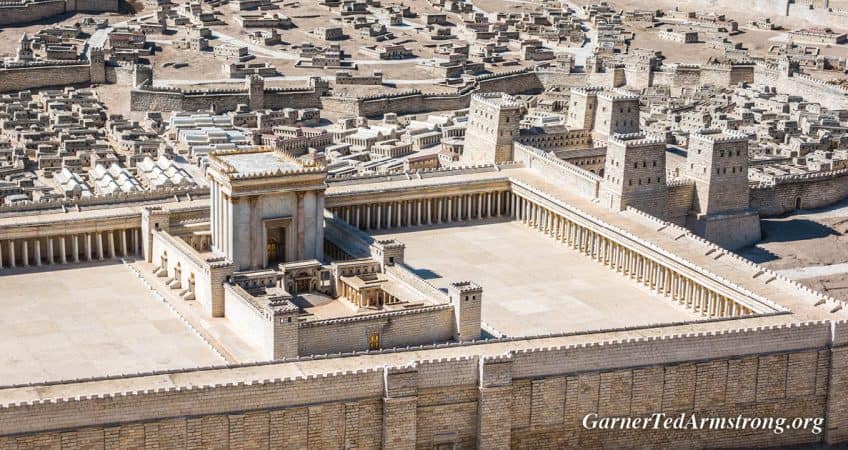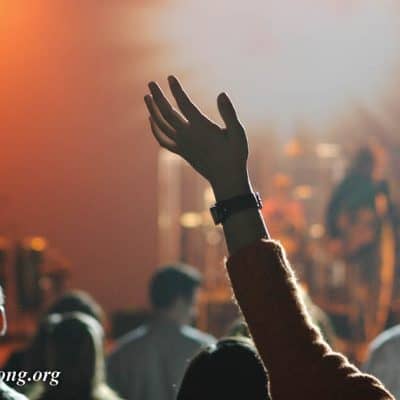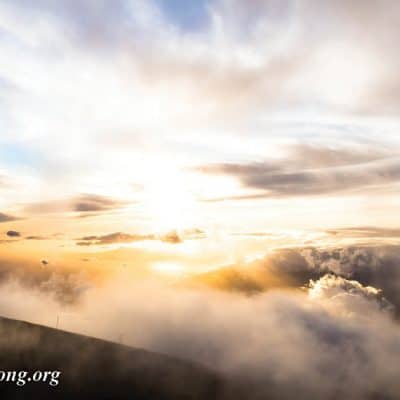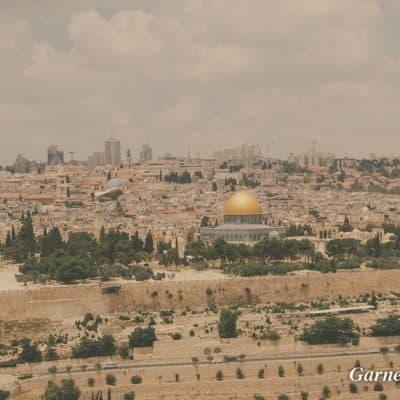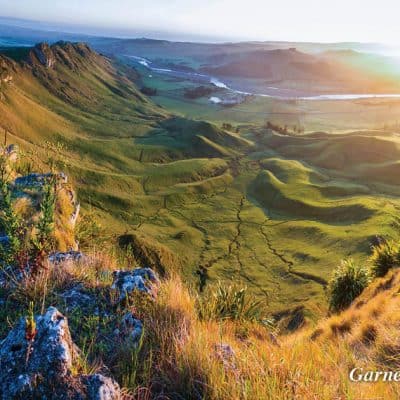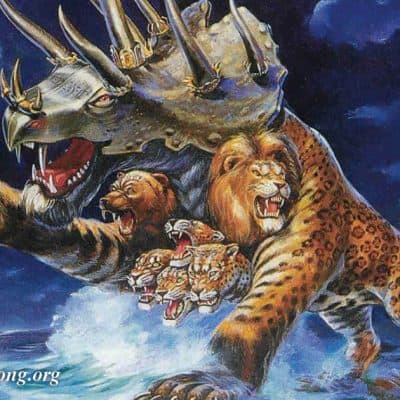Palestinian Arabs are bitterly aware of plans by Jewish sects to build a temple in Jerusalem. What infuriates them, and many Arab governments throughout Islam, is that two of the holiest places to all Muslims, the Al Aqsa and Dome of the Rock Mosques, are located on the site of the former Jewish temples. During our recently-completed visit to Jerusalem, we interviewed Gershon Salomon, leader of the “Temple Mount Faithful.” His attempt, only a few months ago, to lay a symbolic cornerstone for a new temple created a riotous stone-throwing response from Arabs, resulting in the shooting deaths of 21 Arab youths. Perhaps no issue in the Arab-Israeli conflict is more volatile than the move toward building a temple in Jerusalem.
Why should Jerusalem be such a boiling trouble spot?
Why should this city of biblical history, the city of David, the “city of peace,” be such a perennial bone of contention a city of violence, riot, and murder? Why should the question of who controls Jerusalem be at the root of WAR?
Think of it. Israel, one of the smallest nations on earth, sandwiched between hostile Arab neighbors in the Middle East, wants only one thing: peace.
When the true horrors of the Holocaust became known, a conscience-stricken United Nations finally passed a resolution allowing the creation of a Jewish homeland in Palestine, on May 14, 1948. For years, frantic refugees from Europe, from ports in Southern France, tried to emigrate to Palestine. Many shiploads were turned back by the British. Wretched escapees from Hitler’s extermination camps were forced to remain aboard their overcrowded ships, to cry helplessly as they saw Haifa fading into the distance as their ship sailed for Cyprus, or back to Europe.
Finally, in May of 1948, the British occupying forces with-drew from Palestine. The very next day came the unilateral declaration of independence of the state of Israel.
Immediately, combined Arab armies from Lebanon, Jordan, Syria, Iraq and Egypt attacked the fledgling little Jewish state. In a bloody war, Israel managed to hang on to a narrow strip of land between Haifa and Gaza which included the city of Tel Aviv, and which featured a huge double bulge of territory on the West Bank of the Jordan, extending up into the mountains and down across the maritime plain to within only 10 kilometers of the Mediterranean, occupied by Jordan.
The map of Israel from 1948 to 1967 shows clearly the terrible vulnerability of the little country to attack from the Golan, Gaza and Egypt, and from the West Bank.
Yet, in those 19 years, Israel, though building a powerful citizen army, never attempted to dislodge the Jordanian Army from the West Bank bulge, nor from the old city of Jerusalem.
During those 19 years, bloody terrorist atrocities took place from one end of Israel to another; from the Golan, Southern Lebanon, Gaza, and the West Bank, guerrilla bands infiltrated Israeli farms and towns, killing men, women, and children.
Israeli farmers had to weld sheets of metal on their tractors as they farmed fields along the narrow eastern shores of the Sea of Galilee.
During this protracted 19-year period, there was never any suggestion on the part of Jordan that its prime tourism centers of Jerusalem and Bethlehem should become part of a “separate Palestinian state.” There was no political move on the part of indigenous Palestinians to force the Jordanian government to set up a Palestinian state.
Syria never mentioned any attempt to set up a Palestinian state in the Golan. Lebanon never mentioned any desire to see a Palestinian state in southern Lebanon. Egypt did not mention, or attempt to set up, a Palestinian state in the Gaza Strip.
But following the Six-Day War, a war Israel did not want and did not start, Israel emerged victorious and in possession of these territories. Hundreds of thousands of Palestinian Arabs fled the West Bank and the Old City. Shortly after the war in 1967, the outcry began.
The outcry was not for the return of the West Bank to Jordan, the Gaza Strip to Egypt, but for the creation of a separate Palestinian state!
Only in the case of the Golan was there an exception. To this day, Syria demands the return of the Golan Heights.
During the 19 years that Jordan occupied the Old City of Jerusalem, earning tens of millions each year from the tourist trade, Jews were denied access to their holy places. Christians could only visit their holy places by going to Jordan, staying in Jordanian hotels. They could not go to Israel and cross into Jordan. Any American, or nationality of any other country whose passport bore a stamp from the state of Israel (which the Arabs refused to admit existed, or had the “right” to exist) was denied entry to that Arab country.
Immediately following the war in the Gulf, a U.S. senator was initially denied entry to Saudi Arabia because his passport bore the stamp of Israel’s Ben Gurion Airport! No matter that Israel had absorbed vicious SCUD attacks and refrained from responding, Saudi Arabia and all other Arab states, with the exception of Egypt, are not yet prepared to admit Israel “has the right to exist”!
Why should Jerusalem be the catalyst for continued strife?
First and foremost, because it is the “holy city” to the three great “monotheistic” religions: Christianity, Judaism, and Islam. Each religion claims specific “holy places” exist in Jerusalem places where events of great spiritual and historical significance took place.
Each religion reveres these “holy places,” and believes any intrusion by members of other religions into them is a “desecration.”
Christians know Christ taught in the temple, and that the temple that stood in Jerusalem during Christ’s time was the second temple, a structure often called “the Herodian temple,” which was built over the centuries after Nebudchadnezzar destroyed Solomon’s temple more than five hundred years before Christ.
The second temple was destroyed by Titus and his Roman legions in 70-71 AD.
Between 685 and 691 AD, the “Dome of the Rock” was built by the caliph Abd al-Malik ibn Marwan. Originally, it was not intended to be a mosque, but merely a pilgrims’ shrine. Muslims claim it sits over the rock from which Mohammed supposedly ascended to heaven, while Jews claim it sits exactly on the site of Solomon’s temple, which itself sat on the site where God told Abraham to sacrifice Isaac.
Thus, Jews revere the site from an event which has everything to do with the very existence of the Jewish people: the saving of Isaac, who was the father of Jacob, whose name was changed to Israel, and who was the progenitor of the 12 tribes.
The Jews also recognize that both the temple of Solomon, and the later Herodian temple stood on this same rock. They know all Jewish spiritual life revolved around the daily sacrifices offered by the Levitical priesthood; that great annual Sabbaths, like Passover, the Feast of Weeks, Atonement (Yom Kippur), and the Feast of Tabernacles (Succoth) featured special offerings in the temple.
Christians revere the site because of events in the life of Christ: His teaching of the doctors of the law inside the temple; His many parables and examples delivered there; His overthrowing of the moneychangers, and reference to the temple as “My Father’s house.”
Is Another Temple to be Built?
If one takes literally what Jesus Christ said, and what Paul wrote, it appears a temple is yet to be built in Jerusalem! Jesus said, “See ye not all these things [indicating the Herodian Temple with all its associated columns and walls]? Verily I say unto you, there shall not be left here one stone upon another, that shall not be thrown down” (Matthew 24:2).
His startled disciples asked Him to tell them when this great calamity would occur, and what would be the sign of His coming to be crowned as King, and the sign of the “end of the age.”
Among all His prophecies of disaster, calamity and war, Christ once again specified events to take place within the temple. He said, “When ye therefore shall see the abomination of desolation, spoken of by Daniel the prophet, stand IN THE HOLY PLACE (whoso readeth, let him understand:) then let them which be in Judaea flee into the mountains…for then shall be GREAT TRIBULATION…” (Matthew 24:15-22).
When Christ delivered this warning, His disciples could look across from the top of the Mount of Olives and see the temple of which He spoke. There was no doubt in their minds what Christ meant. He meant the temple, and the “holy of holies” inside the temple, where the high priest entered only once each year on the Day of Atonement; the room which contained the Ark of the Covenant, the original Ten Commandments, written with the finger of God, the original “Torah” or “book of the law,” contained in the side of the ark, and Aaron’s “rod that budded,” together with the stone jar of manna.
Christ specifically stated that when the world would see a despicable, detestable, hated IDOLATROUS thing, or person, set up inside this holy place then GREAT DESTRUCTION and desolation would occur.
The “abomination of desolation” merely means a hated, idolatrous thing which is detestable to God which will cause destruction, or desolation.
The destruction of Jerusalem and the Herodian temple by Titus’ armies in 70-71 AD was but a forerunner of what is yet to occur.
Many prophecies are dual in nature, having a former, or “typical” fulfillment, and a later, or literal fulfillment. >From reading Matthew 24, Mark 13 and Luke 21, the parallel accounts of the “Olivet Prophecy,” it becomes clear that, even though there were horrifying calamities wrought upon the Jews in Jerusalem by Titus (Josephus, the famous Jewish historian, writes graphically of the slaughter of thousands of Jews, including burning and impaling), the heavenly signs did not occur, Christ did not return, the Day of the Lord did not come.
Yet, Christ specifically said all these signs were to lead toward His return to this earth, and the setting up of the Kingdom of God.
Therefore, there is a yet future fulfillment of Matthew 24 which must occur.
When Paul wrote of the “man of sin” sitting “as God,” sitting “in the temple of God,” the temple yet stood! Some have begun to believe this scripture means the church. It is true the analogy of a temple, or a house, or a body, or a bride, is used to connote the church. But Paul was not using analogies when he wrote plainly of a building which yet stood in Jerusalem.
Must a temple yet be built in Jerusalem to satisfy these prophecies? It certainly seems so. Would a temporary structure, even a pavilion of some sort, over a symbolic cornerstone, suffice? No one can say with any certainty. However, it appears there must be a “third temple” completed, with a priesthood established, sacrifices begun, and the entire ritualistic pattern of Judaism restored before the “man of sin” can claim to be God and move into this temple thus fulfilling the prophecy of the abomination of desolation.
Remember, Paul warned, “Whether there be prophecies, they shall fail” (1 Corinthians 13:8). This is not to say prophecies generally fail, or that all prophecies shall fail. It reminds us of Christ’s warning that no man knows the day and hour of His return; that we are to watch so that we are not unaware; that we are to be alert, and not spiritually asleep.
Also, God plainly says He will “cut short” the time! Painstaking charts, graphs, cycles, and chronological and historical scenarios notwithstanding, Christ will return to this earth to RULE it with a rod of iron!
Since Christ Himself laid special emphasis on the “abomination of desolation,” it behooves us to watch for such a development!
Now, think of the enormous geopolitical impact upon all the world, especially the Islamic nations, if a temple were to be built on the temple mount. Remember, before any such structure could be built, the famous Dome of the Rock, and the Al Aqsa Mosque would either have to be moved, or destroyed!
For the Israelis to so much as touch those buildings is considered BLASPHEMOUS and a terrible desecration to the Arabs!
Not too long ago, I was reading the Jerusalem Post in my room in Jerusalem’s Hyatt Regency Hotel. A letter from an indignant citizen took issue with Arab charges that the “Jews had tried to burn down the Al Aqsa mosque” many years earlier when considerable damage was done by an arsonist.
The writer pointed out that a “deranged Australian,” not a Jew, and certainly not a citizen of Israel, had torched the mosque. The reason for the letter? Because Palestinian Arabs are still smarting over attempts by the “Faithful of the Temple Mount” to build a temple in Jerusalem!
Just prior to the outbreak of war in the Gulf, the rock-throwing, shooting incident described above created an international incident; caused wailing, emotional demonstrations by thousands of Palestinians as they buried 21 youths, shot by Israeli security forces.
The other day, I interviewed Faisal Husseini, one of the leading intellectuals of the Palestinians in Jerusalem, only three days after he had met with Secretary of State, James Baker III. On Mr. Husseini’s wall was a bizarre painting. It appeared to be 21 individual gouts of blood over a black background, each spattering of blood oozing down toward the door of the Al Aksa Mosque. The title was “The Massacre,” giving the date of the occurrence.
This grotesque painting had been presented to Mr. Husseini in the wake of the shootings of youthful stone-throwing Arabs in the Old City.
My interview with him once more demonstrated how little real progress has been made between the state of Israel and its Arab neighbors in the search for peace. Mr. Husseini reiterated his firm loyalty to the PLO as the sole representative of the Palestinians in the West Bank and Gaza; rejected my suggestion that an “alternative leadership” among Palestinians would be more acceptable to both the U.S. and Israel.
For their part, the Israelis point out there was never any attempt on the part of the Palestinians to achieve a “separate Palestinian state” until after the Six-Day War, when Israel ended up in possession of the West Bank (including the Old City of Jerusalem), Gaza, and the Golan Heights.
When I interviewed Mayor Teddy Kollek of Jerusalem the previous night, at his eleventh hosted convention of Mayors, and asked him if the Israeli government would ever consider allowing the Old City to become a national capitol for a Palestinian state, he said, forcefully, “Absolutely not!”
When I mentioned to him the U.S. media was hyping the suggestion that the Israeli government was ready, in the wake of the war in the Gulf, to “swap territory for peace,” he retorted, “As for Jerusalem, we shant give an inch.”
Mayor Kollek orchestrates the “unified, peaceful city of Jerusalem,” which he says has been restored as the historical, religious, cultural and political capitol of the Israeli nation. Continually, he cited the policy of the government, and his own policy as Mayor of the city, to permit free access to all religious faiths to their holy places.
During the Jordanian occupation of the city, it was a different story. According to Mayor Kollek, the Palestinian Arabs not only denied Jews access to the wailing wall (the west wall of the Herodian temple), but they demolished fifty-eight synagogues in the area. As illustrated by the Crusades, when zealous religionists capture a “holy place” belonging to another religion, they consider it “pagan”!
Invariably, Muslims have destroyed Christian and Jewish “holy places.” Through the centuries, “Christians” would destroy Islamic and Jewish holy places, substituting for them structures of their own. It is no accident of history that Islamic holy places now occupy the “holiest” of all places to the Jews, for it was done deliberately, not only as an insult to the Jews, but as a proud statement that the “one true religion” of Islam had now removed the “false religious artifacts” of the Jews.
The Temple Mount Faithful
The day following my interview with Mr. Husseini, my son, Mark, interviewed Gershon Salomon, whose march to the temple mount precipitated the riot and killings. Here are major excerpts from that interview:
Question: “When was the Temple Mount Faithful movement started?”
Answer: “The Temple Mount Faithful movement was founded immediately after the Six-Day War when the Israeli army the heroes of the Israeli army liberated the temple mount in Jerusalem after two thousand years of the diaspora [the dispersion of the Jews] and the destruction of the temple mount in Jerusalem, and the historical belief that the dreams of the Jewish and Israeli people were fulfilled.
“Unfortunately, the Defense Minister of Israel, Moshe Dyan, decided to give back the temple mount to the Arab occupiers this very, very holy place of the Jewish people.”
Question: “When you say give back,’ do you mean allow them access and control over the Dome of the Rock?”
Answer: “Yes. Gave them back the temple mount…the heart of our history…a symbol, more than a symbol; a symbol of every feeling of our people a religious symbol, a spiritual symbol, a morality symbol, a national symbol.
“And this place on the temple mount was [where] the prophets of Israel, [in] the Bible [taught].
“The temple mount [represents]…all the history of the Israeli people, more than four thousand years, and now after the liberation of the temple mount in the Six-Day War, everyone, every Jew from every corner of the world and [here in] Israel feel that an historical dream a dream of two thousand years of terrible diaspora…was fulfilled and Moshe Dyan broke this dream in one moment.
“He gave back the temple mount to the enemies of yesterday and the enemies of tomorrow.”
Question: “But Israel still controls this section of the city, still occupies it militarily. So, in a sense, it has not really been completely returned; it’s just been allowed to be used for worship is that right?”
Answer: “No. It is not exactly because the day after the Six-Day War the gates of the temple mount [were] closed to Jews who wanted to come to this very holy place and most holy place to the Jews. The gates were closed before the Jews. They were not allowed to pray. Jews can pray today in New York, London and Paris, Tokyo and every place, even in the Red Square in Moscow, but not in the most holy place the only one most holy place of the Jewish people of the temple mount.”
Question: “And that’s up on top of the wailing wall where the Dome of the Rock sits?”
Answer: “Yes. The wailing wall, or the western wall, is not for us so holy. It [represents] a memory of the diaspora, the destruction; the land of Israel the Jews were thrown out from the temple mount and they prayed here because they had not another choice. [Meaning, “here,” at the wailing wall]. But our hearts, our feelings, everything in our life is up on the temple mount. To us, the Arab occupation of 1,300 years which was made by an Arab Colonialism Coalition, when they…the temple mount in the second century. They built a mosque and the Dome of the Rock on the place of the temple, as you can see them just now. They did it in many other countries which they occupied in imperialistic occupation, like in Istanbul they changed their church which was the eastern center of eastern Christianity. They built, in [a] very holy place for Christians, a mosque. They did it in Spain; they did it in North Africa, the Balkans, every place.
“To give legitimization to the Arab imperialistic occupation of those countries, they did the same thing on the temple mount. You must know that Arab occupation of the temple mount was finished after the Six-Day War and the memories of this Arab imperialistic occupation of the temple mount must be finished.”
Question: “So you feel that the opportunity to reclaim the temple mount for Jewish people, for the Jewish religious people, is past since Moshe Dyan gave it back?”
Answer: “I can’t say past temporarily.”
Question: “Tell me, how many Temple Mount Faithful members are there?”
Answer: “We have thousands of members. We have, let’s say we feel, and we know, that most of the Israeli people are with us.”
Question: “When you say with us,’ what is the goal of the Temple Mount Faithful?”
Answer: “The goal of the Temple Mount Faithful is first of all to liberate again the temple mount from Arab occupation. It means that Jews must come and can come again to the temple mount to pray and worship God.”
Question: “Can the Dome of the Rock be there? Can it sit where it does under those circumstances?”
Answer: “The temple mount must be again as it was this is the will of God and the will of history. The temple mount must be again a religious, national and a spiritual and moral symbol of the Israeli people. And of the next…to be a place of strength for all the world, but first the temple mount must be again a place of worship. The temple must be built on this place.”
Question: “Where the Dome of the Rock sits?”
Answer: “Yes. The Dome of the Rock, as I told you is a result of Arab imperialistic occupation. The Al Aqsa mosque, the Dome of the Rock.”
Question: “And the al Aqsa Mosque as well?”
Answer: “Yes.”
Question: “The al Aqsa Mosque is also in the way?”
Answer: “Yes. They are here in this place as a result of the Arab imperialistic occupation. I want to ask you a question. What would be the Arab reaction if one day in Mecca Christians would build a church in the middle of Mecca in the most holy place for Muslims? Would they live with such a situation? Or if we were to build there a synagogue. I can understand, they will fight against it. In the same way, I ask the Muslims, I ask Christians, everyone in the world to understand, the temple mount is a symbol of one place, a symbol of the Jewish people, of the Israeli people. This is a place of the temple, of the third temple.
“This was the prophecy of the prophets which says that after the Israeli people will come back one day from the diaspora to the stolen country…the land of Israel, by the will of God, the third temple will be built. Those days came just now we are living now in those days. The foundation of the state of Israel [was] in 1948. From this day until now, God helped us to win all the wars that Arabs made against us with one goal, to destroy the land of Israel to push us to the sea, and to continue the Arab imperialistic occupation of Jerusalem and the temple mount, by the will of God, as I told you, it was finished. We came back to our country forever. And I cannot imagine an Israeli state, this country, without the temple mount and the third temple in the middle of it; without Jerusalem as the capitol of this Israeli country.
“I wish to tell you another thing. You know we live now in a world without peace. Not only in the Middle East. Peace will come to the world only in one condition. When the terrible suffering of the Israeli people will be finished. When the Israeli people will live in its original historical country the land of Israel forever.
“We cannot give one piece of our country to our enemies. Not the temple mount, not Jerusalem, not Judaea, not Samaria, not Gaza. Because this country, including all those places and even trans-Jordan, was given, was offered us by God, by Abraham, he told him this country I’m going to give you and your people forever. No one can take the country, the land which God gave us forever. The Arabs are waging a war against us. It is a war against the will of God, against the will of Israel to win, the will of the people to succeed. And I ask them to keep up…but to do it in a way of peace. Because this little country is a country of the Israeli people. They have 22 countries [the Arabs] as they have 14 1/2 million square kilometers from the Atlantic Ocean to the Persian Gulf. We live in this little, very little country including 25 thousand square kilometers only, including Judaea, Samaria and Gaza.”
Question: “So it is the wish of the Temple Mount Faithful that Jordan also be reclaimed as part of greater Israel?”
Answer: “You must know the Arabs asked of us to give up this side of the Jordan. Anyone that will open the Bible and read it and know that even trans-Jordan was a part of the land of Israel…”
Question: “Is it the goal of the majority of the Israeli people that Jordan and possibly Syria…be reclaimed as part of greater Israel?”
Answer: “Not Syria but trans-Jordan is a part of the land of Israel. But at least we ask to leave us to live in this part of the Jordan which is the little part of the historical land of Israel which in the past was including the trans-Jordan, Sinai and other parts. Now we have in our hands only this little part of our historic country. I mean from Jordan to the sea. The Arabs have so many countries, so many territories. If you take the world map you almost cannot see the state of Israel, it is so little.”
Question: “From a political standpoint, how far is your organization from achieving their desire to remove the Dome of the Rock and construct a third temple on the temple mount?”
Answer: “We believe and we know it that it must happen.”
Question: “When?”
Answer: “Soon. It can happen today, it can happen tomorrow.”
Question: “By what means? By political means? By force?”
Answer: “It will happen by the decision of our government… our government must decide and we believe that it must happen soon.”
Question: “What do you think the reaction of the Arab world would be?”
Answer: “I think they will leave it after all, they know better than everyone that their presence on the temple mount in Jerusalem is a temporary presence. That they hold this very holy place to the Jewish people…”
Question: “From a practical point of view you’ve seen in the Gulf War how Saudi Arabia and Syria, very unlikely partners in the coalition, came together for a common cause. What do you think would become of relationships between those countries and the United States, between those countries and Israel, and between Israel and the United States, if Israel were to force the rebuilding of the third temple where the Dome of the Rock and the al Aqsa Mosque, two of the holiest sites of Islam, sit on the temple mount?”
Answer: “First of all about Syria; I must tell you. Saddam Hussein and Assad are the same figures. The difference between them is only the name. This Assad [is] the same dictator [as] Saddam Hussein. He is a dictator which rules by force against his people on his people and he never gave up his very old dream to destroy Israel and make Israel the southern territories of Syria.”
Question: “Do you believe he still holds the dream of conquering Israel?”
Answer: “Sure. For him to be in the coalition against Saddam Hussein was opportunity to fight against his Arab enemy. You must know we live in the Middle East we are surrounded by Arab countries which…is a culture of cruel violence. See what they are doing to each other…in the Persian Gulf, in Kuwait, in Iraq. See how Saddam Hussein is killing now his own people. See what Assad did in Hama (An entire Syrian city entirely destroyed by Assad’s army following a public outpouring of dissent). Arabs are killing each other in Lebanon. They are doing the same in Sudan in other Arab countries. We must survive between those cruel peoples and continue our biblical culture which means peace, morality and a mission for all the world. A new order not a new order which will destroy Israel which will divide Israel make Israel a little land which cannot continue and survive this terrible area. A new order means the fulfillment of the prophecy of the prophets. Which means morality principles of the Bible which will be a part of all the world in the base of every line and every corner of the world. This means a new order.”
Question: “Do you think that the implementation of your goals would affect relations between the United States and Israel?”
Answer: “I believe and I know it, that America, the United States of America felt a special mission, an historic mission for this age and in the future. I believe that God founded the United States of America special for this mission. This mission means, first of all to help the people of Israel and we believe that we and Americans are brothers. God gave the mission to help us to live again in our historical biblical country in our original land, the land of Israel. We have the same principles of morality and peace the right peace not the wrong peace but the right peace. The spirit of the Bible. The same spiritual principles. Our religious principles are very close, very close. We and you together are taking our principles from the Holy Bible, and for our common mission for good. So America has a very important task to fulfill these principles. To help the people of Israel to live this life in this country.”
Question: “From a practical point of view, though, what do you think the United States’ public reaction would be? Have you ever tested your plans or your goals on any leadership of the United States in order to get a reaction?”
Answer: “In the last years I met many, many leaders, Christian leaders, political leaders from the United States of America. I had with them very long and deep conversations about those goals for our people. I believe that our goals are the goals of the Israelis. And they showed me very strong support. I know that many, many millions of American Christians support the goals of…coming of the Israeli people to his historical country. The big goal of rebuilding of the third temple from this holy place of the temple. They came here, they told me they are ready and they want it they ask to help us in any way to fulfill this big goal of God and the history. They support our feelings toward Jerusalem. They support our very good feeling that Jerusalem must be again the capitol of the people of the Bible. I was very excited to hear it. I felt that very strong connections more than connections I can say by the brotherhood of connections between us and America, will be the power, first of all a power of morality which will fulfill this historical presence which the prophets offer to the Israeli people for one thousand nine hundred and twenty-one years when this place, the second temple, was destroyed by the Romans. Our going through the diaspora was very temporary. We came back here by the will of God and thanks to God that we have so an wonderful ally like America which push America to…the principles, spiritual principles and the very deep belief which comes from the very Holy Bible which is common to us together.”
Question: “The events of last August could you tell me a little bit about that? What was it all about? What was the purpose of your coming here on that day?”
Answer: “What happened last August was a result of Arab hostility. You must know the last 23 years…”
Question: “I would like to know first…I’m aware of their reaction, but I would like to know the purpose of your coming here and exactly what that mission was all about.”
Answer: “It was the holy of Succoth. We came here to celebrate this very holy day and very natural in our most holy place on the temple mount.”
Question: “That’s not been accepted here before, has it?”
Answer: “What do you mean?”
Question: “For a religious Jewish ceremony to take place up on top of the temple mount.”
Answer: “Yes, yes. We came here with the very deep support of every Israeli. We came here by a very act of peace to celebrate this very holy day…we did it together with the police, very carefully.”
Question: “And were you planning to lay was it a symbolic cornerstone?”
Answer: “Yes. We planned to put a cornerstone for the third temple. We tried a year before one year before in Succoth.”
Question: “What were the means of transporting it up to the temple mount?”
Answer: “If we had the permission, it would be very simple.”
Question: “Were you trying to transport it on that day last August?”
Answer: “No, because we had not the permission of the police or the permission of the government. Not because they are against….”
Question: “Do you believe this stone that you’ve chosen will be the eventual cornerstone of the third temple?”
Answer: “Sure, sure. This corner is the first cornerstone which Israelis and Jews brought to this holy place to the temple mount after two thousand years and it will, very soon, be the first cornerstone for the third temple. We came here, you know, with a voice of peace and spiritual act. And the Arabs reacted with hostility and violence. We had not the permission as I told you to lay the cornerstone. Not because the government or the police are against it the feelings, the principles. But because of only one reason. Not to bring the Arabs to an action of violence. Now, according to my feelings, it is an act of weakness for our government, I’m sorry to say. Because the Israeli government must be strong and continue to fulfill our historical principles, our Zionist historical principles.”
Question: “But the practical outcome that day was a blood bath. Don’t you think that there will be future blood baths that there will be one ongoing blood bath if in fact an attempt is made to destroy the Dome of the Rock or to dismantle and move it and the al Aksa Mosque?”
Answer: “No I don’t think the Arab reaction was because of us. When this violence happened on the temple mount we were far from here. The police informed the Arab leaders on the temple mount…that they would not allow us to go in there. Even without the cornerstone, they knew that this day we will not be on the temple mount. They attacked very silent Jewish prayers near the western wall.”
Question: “So you weren’t here when that took place?”
Answer: “We were not here we were far from here down in the Shiloah Pool river which is from here one kilometer and they attacked these people.”
Question: “Because they heard you were coming?”
Answer: “No, I don’t think so. Maybe we were the alibi for their activities. Their intention was to bring again the public international attention of the Persian Gulf…back to here, back to Jerusalem. To bring the attention of America, of the U.N. Security Council and say the problem is not in the Gulf, but here. There is a…linkage between the Gulf and here. So no one made provocation they made the provocation. They started to throw stones from the temple mount to the western wall.”
Question: “And the stones came down over the western wall and fell on…?”
Answer: “Thousands of stones I was here when…I came back after it started…I saw what happened here. Thousands of stones, big stones, sharp stones, which could kill hundreds of Jews here near the western wall. It is a miracle that only 20 was wounded, but none were killed. No one started to throw stones from the western wall to the temple mount. They started it.”
Question: “Are you well known among the local Palestinian population?”
Answer: “If I am very well known, I think that they know that I am a man of principles.”
Question: “Do they recognize you here?” (In vicinity of temple mount.)
Answer: “I think that they honor my feelings even [though] they are against them…is a just way they feel that it is the will of God, the will of history. Very deep in their hearts…real goals, real principles of the Bible and maybe of their own belief….”
Question: “You don’t fear for your safety amongst the local Palestinian population?”
Answer: “No. I’m afraid only from one big God, not from any special Arabs, you know I feel that I have a very important special mission. God is with me. God helps me, God defends. So I’m not afraid of the Arabs. I think that they are afraid of me…maybe not physically…but they feel that what I am doing is the right thing which God wants.”
Question: “How can they believe that when they believe in a different god altogether?”
Answer: “It was a few days before the Six-Day War. I was an officer of the Israeli army. And I defended the Israeli villages which was attacked again and again by the Syrian army. They tried to kill me in those days and they did not succeed. They are trying today to do it again and they don’t succeed. I told you when we started to speak the Arabs are fighting today, not only against the Israeli people, first of all they are fighting against good, against the will of God and against the will of history. They have no chance to succeed in such a war. So you can see again and again they are failing in the wars against Israel. Not because by physical presence in this world. I feel very strong because what I am doing is principles of the prophets. It is a mission of God. The God of Israel. And as I told you, what I am doing is in the mission. They are rebuilding again for our historical biblical country, the land of Israel. They build it again the…temple. Finish the Arab occupation, imperialistic occupation from the temple mount. Finish the Arab imperialistic presence, violence by…as you can see…trying to kill Jews here in Jerusalem and every place of Israel Judaea and Samaria and Gaza. Every Christian here and Muslim knows and if he don’t know, please, I ask him to open the Bible which is holy for them and see that it was the city of King David…our kings, it was the city of the prophets and will be again the future as in the past. We are living now in a special danger…but not less the history of all the world. I can see that every event in the world today is connected to this little, but big country, the land of Israel. The attention of all the world is here, sometimes by supporting, sometimes against the people of Israel. Little people today in Israel four million. Against us we have enemies of 250 Arab millions which want to destroy us. No power can destroy us and stop the fulfilling of this historical mission of our people to fulfill their vision of the prophets rebuilding again this historical country for our people…to be again the country and the people which will bring to all the world the spirit of peace, belief, and biblical principles.”
Question: “So you’re saying that in order to fulfill your movement’s goals, the Dome of the Rock and the al Aqsa Mosque would have to be destroyed to make room for the building of the third temple?”
Answer: “Not destroyed. We are not barbarians. No, the Arabs, they occupied Jerusalem before the war…they destroyed all the synagogues…we are not barbarians. What we are saying, we shall, by the will of God, we shall dismantle very carefully, with a very big respect, those two buildings, the Dome of the Rock and Al Aqsa Mosque, and rebuild them again in the right place, Mecca.”
Gershon Salomon’s organization has not only gained international attention, it has directly contributed to a major international incident the massacre mentioned earlier and managed to inflame Arabs the world over.
Turbulent Times Ahead
Like a boiling kettle, the Middle East continues to steep and seethe with age-old animosities. Unfortunately, the war in the Gulf, though ridding America of the “Vietnam syndrome,” proving to the world America’s technology is second to none, and displaying to the world that America is truly the world’s major superpower, did not produce lasting peace in the Mideast. Not between Israel and its hostile Arab neighbors. Not in Iraq. Not in Kuwait. Not in Lebanon.
Today, It appears Saddam Hussein’s brutal extermination of his political foes in Kurdistan and the Shiite south has allowed him to cling to power in war-ravaged Iraq.
Western concerns run a wide gamut. The White House does not want to see a fundamentalist Shiite revolution, backed by Iran, overtake the country; prefers to see the Sunni minority, minus Saddam Hussein, in power. But the wishful thinking of Washington will probably not prevail. With Syria, Turkey and Iran all hoping to slice off a significant piece of the war-torn country; with ongoing massacres of helpless civilians from the north to the south, the future of Iraq is by no means sure. Kuwait is continually threatened by Iraq and harbors a restless populace ruled by an inefficient ruling family in Kuwait which may not be able to maintain its grip.
Syria receives of a Chinese-made weapons and SCUDS. Against whom, ask the Israelis, would Hafez al-Assad use such indiscriminate terror weapons?
Lebanon is in chaos, mostly occupied by Syria.
With wide spread political and economic unrest in the region, what real chance is there for a settlement of the “Palestinian Question”?
As I have been writing and saying for over 40 years, we need to watch the Middle East watch Jerusalem! The Bible is written from the perspective of Palestine. It looks out at the world from the vantage point of this ancient land.
Christ is to return to Zion, the city of Jerusalem!
The “abomination of desolation” that triggers the beginning of the Great Tribulation is to be set up in the holy place in Jerusalem!
It is because of the incredibly important place Jerusalem occupies in history, in geopolitics, in the major world religions, that I recently went there with our crew to conduct interviews with leaders on both sides of the volatile “Palestinian Question.” I did not find any so-called “window of opportunity.” I found, instead, hatred, implacability, unforgiveness, self-justification. I found, instead of opportunities for peace, the seething hatreds and narrow-minded racial, political and religious points of view that will, sadly, lead to yet other wars in the Mideast.
In the months and years ahead, we will begin to see who is the “king of the South” of Daniel’s prophecy (Daniel 11:40-45); who is the “beast”; the super dictator over a 10-nation combine in Europe; who is the “false prophet,” the “man of sin,” who will move into a temple which is yet to be built.
We need to watch for these things, and be busy in God’s work, doing the work of the watchman (Ezekiel 33).
Will a temple soon be built in Jerusalem? If The Temple Mount Faithful had their way, work would have begun yesterday! The present right-wing Israeli government seems determined to pursue continual building of settlements; immigration of thousands of newly-arriving Soviet Jews and other Israelis into the West Bank, which is “defacto annexation,” to continue to say they are “ready to talk,” while agreeing to no concessions as prior conditions to talks.
The Israelis have accepted the PLO as the “legitimate” representatives of the Palestinian people, although Syria, Jordan and other Arab states have yet to fully admit Israel has a right to exist in the region, to “recognize” that Israel exists.
They still say, “Let’s talk.”
Though the media, quoting Secretary of State James Baker, seemed to indicate a “window of opportunity” existed in the immediate aftermath of the war in the Gulf for settling, once and for all, the “Palestinian Question,” my interviews with Israeli and Palestinian leaders alike strongly indicate there never was any such “window.”
Former Prime Minister Yitzhak Rabin indicated to me he would be flexible, if he were in a position to influence events, in discussing Palestinian autonomy. He envisions Palestinian self-rule without “statehood,” or a national security force (read: Army).
Time will tell. Meanwhile, since Jesus Christ of Nazareth tells us to watch and pray always so we might be accounted worthy to escape the terrible things that are to come to pass (Luke 21:36); since He specifically said we would know the Great Tribulation was to begin just as we saw an abomination of desolation set up; since we know the Temple Mount Faithful are determined to see a temple built it is obvious much is in place for major prophetic events to occur in the months and years ahead.
The war in the Gulf did not mean an end to hostilities in the Middle East. Unfortunately, Jerusalem, the “city of peace,” continues to be a city of global contention; a city where violent religions, racial and political emotions come into direct confrontation. Again I say, watch the Mideast! Watch Jerusalem!
You may copy and distribute this information only to friends and family without changes, without charge and with full credit given to the author and publisher. You may not publish it for general audiences.
This publication is intended to be used as a personal study tool. Please know it is not wise to take any man’s word for anything, so prove all things for yourself from the pages of your own Bible.
The activities of the Garner Ted Armstrong Evangelistic Association are paid for by tithes, offerings and donations
freely given by Christians and co-workers who are dedicated to preaching the gospel according to Jesus Christ.

